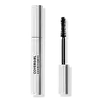What's inside
What's inside
 Key Ingredients
Key Ingredients

 Benefits
Benefits

 Concerns
Concerns

 Ingredients Side-by-side
Ingredients Side-by-side

Water
Skin ConditioningParaffin
PerfumingPotassium Cetyl Phosphate
EmulsifyingCera Alba
EmollientCopernicia Cerifera Cera
EmollientAcacia Senegal Gum
MaskingCetyl Alcohol
EmollientGlycerin
HumectantHydroxyethylcellulose
Emulsion StabilisingPhenoxyethanol
PreservativePEG/PPG-17/18 Dimethicone
EmulsifyingSteareth-20
CleansingPhenethyl Alcohol
MaskingSynthetic Fluorphlogopite
Sodium Polymethacrylate
Emulsion StabilisingHydrogenated Jojoba Oil
AbrasiveHydrogenated Palm Oil
EmollientParfum
MaskingPolyquaternium-10
Disodium EDTA
Magnesium Silicate
AbsorbentPanthenol
Skin ConditioningTin Oxide
AbrasiveBHT
AntioxidantCastanea Sativa Seed Extract
Skin ConditioningEthylhexylglycerin
Skin ConditioningCI 77491
Cosmetic ColorantCI 77492
Cosmetic ColorantCI 77499
Cosmetic ColorantMica
Cosmetic ColorantCI 77891
Cosmetic ColorantWater, Paraffin, Potassium Cetyl Phosphate, Cera Alba, Copernicia Cerifera Cera, Acacia Senegal Gum, Cetyl Alcohol, Glycerin, Hydroxyethylcellulose, Phenoxyethanol, PEG/PPG-17/18 Dimethicone, Steareth-20, Phenethyl Alcohol, Synthetic Fluorphlogopite, Sodium Polymethacrylate, Hydrogenated Jojoba Oil, Hydrogenated Palm Oil, Parfum, Polyquaternium-10, Disodium EDTA, Magnesium Silicate, Panthenol, Tin Oxide, BHT, Castanea Sativa Seed Extract, Ethylhexylglycerin, CI 77491, CI 77492, CI 77499, Mica, CI 77891
Water
Skin ConditioningAcrylates Copolymer
Glyceryl Stearate
EmollientDisteardimonium Hectorite
StabilisingPropylene Glycol
HumectantStearic Acid
CleansingCopernicia Cerifera Cera
EmollientTriethanolamine
BufferingPolyethylene
AbrasiveLecithin
EmollientPropylene Carbonate
SolventPolyvinyl Alcohol
Synthetic Wax
AbrasiveOleic Acid
EmollientAlcohol Denat.
AntimicrobialBenzyl Alcohol
PerfumingAscorbyl Palmitate
AntioxidantPanthenol
Skin ConditioningPhenoxyethanol
PreservativeTocopherol
AntioxidantMethylparaben
PreservativeGlycerin
HumectantEthylparaben
PreservativeSodium Laureth Sulfate
CleansingPropylparaben
PreservativeGlycine Soja Oil
EmollientTrisodium EDTA
Xanthan Gum
EmulsifyingPotassium Sorbate
PreservativeTocopheryl Acetate
AntioxidantAmmonium Hydroxide
BufferingTetrasodium EDTA
Glyceryl Oleate
EmollientBenzoic Acid
MaskingMethylcellulose
Emulsion StabilisingSilica Dimethicone Silylate
AbsorbentDimethicone
EmollientSulfuric Acid
BufferingSorbic Acid
PreservativeIron Oxides
CI 77891
Cosmetic ColorantWater, Acrylates Copolymer, Glyceryl Stearate, Disteardimonium Hectorite, Propylene Glycol, Stearic Acid, Copernicia Cerifera Cera, Triethanolamine, Polyethylene, Lecithin, Propylene Carbonate, Polyvinyl Alcohol, Synthetic Wax, Oleic Acid, Alcohol Denat., Benzyl Alcohol, Ascorbyl Palmitate, Panthenol, Phenoxyethanol, Tocopherol, Methylparaben, Glycerin, Ethylparaben, Sodium Laureth Sulfate, Propylparaben, Glycine Soja Oil, Trisodium EDTA, Xanthan Gum, Potassium Sorbate, Tocopheryl Acetate, Ammonium Hydroxide, Tetrasodium EDTA, Glyceryl Oleate, Benzoic Acid, Methylcellulose, Silica Dimethicone Silylate, Dimethicone, Sulfuric Acid, Sorbic Acid, Iron Oxides, CI 77891
Ingredients Explained
These ingredients are found in both products.
Ingredients higher up in an ingredient list are typically present in a larger amount.
Ci 77891 is a white pigment from Titanium dioxide. It is naturally found in minerals such as rutile and ilmenite.
It's main function is to add a white color to cosmetics. It can also be mixed with other colors to create different shades.
Ci 77891 is commonly found in sunscreens due to its ability to block UV rays.
Learn more about CI 77891This ingredient comes from a palm tree native to Brazil. This ingredient is used to thicken texture and leaves behind a film when applied.
Glycerin is already naturally found in your skin. It helps moisturize and protect your skin.
A study from 2016 found glycerin to be more effective as a humectant than AHAs and hyaluronic acid.
As a humectant, it helps the skin stay hydrated by pulling moisture to your skin. The low molecular weight of glycerin allows it to pull moisture into the deeper layers of your skin.
Hydrated skin improves your skin barrier; Your skin barrier helps protect against irritants and bacteria.
Glycerin has also been found to have antimicrobial and antiviral properties. Due to these properties, glycerin is often used in wound and burn treatments.
In cosmetics, glycerin is usually derived from plants such as soybean or palm. However, it can also be sourced from animals, such as tallow or animal fat.
This ingredient is organic, colorless, odorless, and non-toxic.
Glycerin is the name for this ingredient in American English. British English uses Glycerol/Glycerine.
Learn more about GlycerinPanthenol is a common ingredient that helps hydrate and soothe the skin. It is found naturally in our skin and hair.
There are two forms of panthenol: D and L.
D-panthenol is also known as dexpanthenol. Most cosmetics use dexpanthenol or a mixture of D and L-panthenol.
Panthenol is famous due to its ability to go deeper into the skin's layers. Using this ingredient has numerous pros (and no cons):
Like hyaluronic acid, panthenol is a humectant. Humectants are able to bind and hold large amounts of water to keep skin hydrated.
This ingredient works well for wound healing. It works by increasing tissue in the wound and helps close open wounds.
Once oxidized, panthenol converts to pantothenic acid. Panthothenic acid is found in all living cells.
This ingredient is also referred to as pro-vitamin B5.
Learn more about PanthenolPhenoxyethanol is a preservative that has germicide, antimicrobial, and aromatic properties. Studies show that phenoxyethanol can prevent microbial growth. By itself, it has a scent that is similar to that of a rose.
It's often used in formulations along with Caprylyl Glycol to preserve the shelf life of products.
Water. It's the most common cosmetic ingredient of all. You'll usually see it at the top of ingredient lists, meaning that it makes up the largest part of the product.
So why is it so popular? Water most often acts as a solvent - this means that it helps dissolve other ingredients into the formulation.
You'll also recognize water as that liquid we all need to stay alive. If you see this, drink a glass of water. Stay hydrated!
Learn more about Water